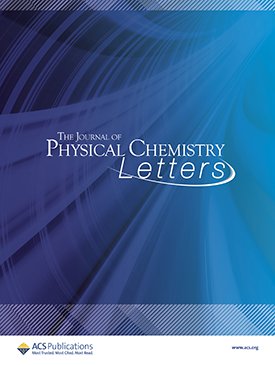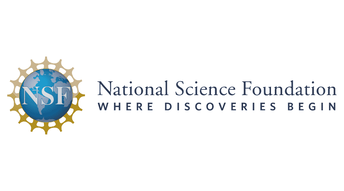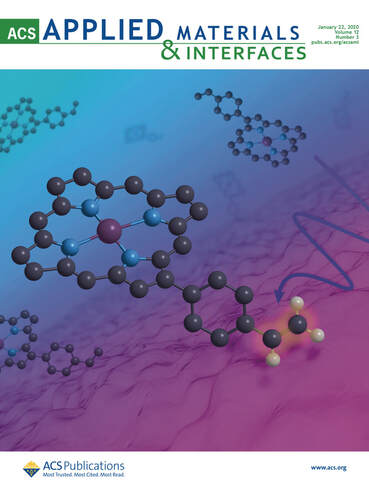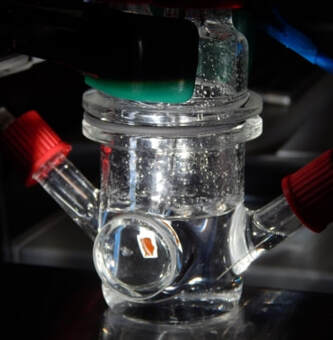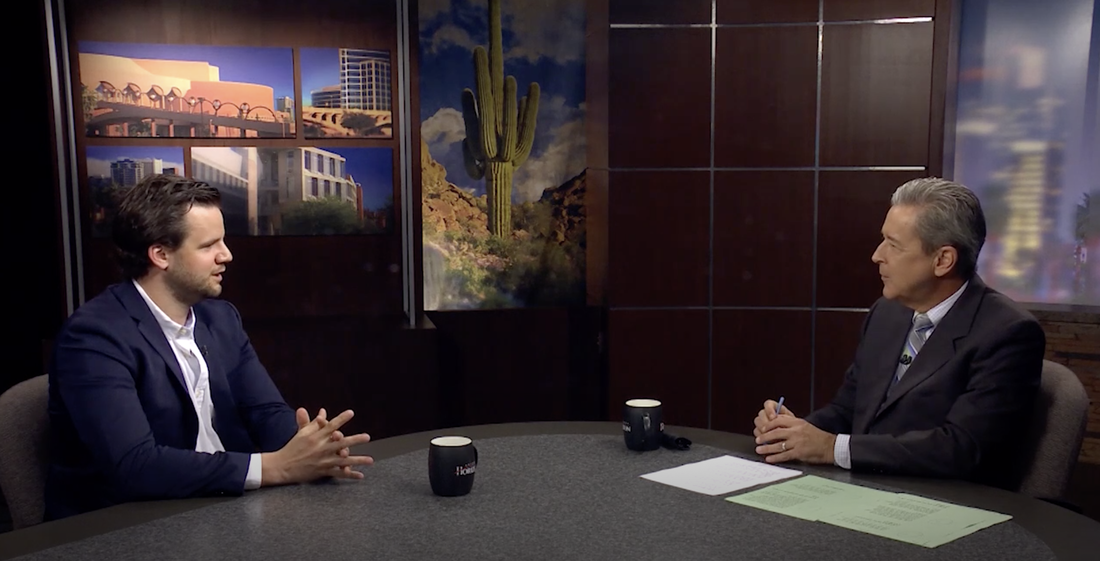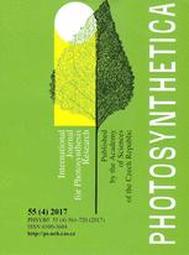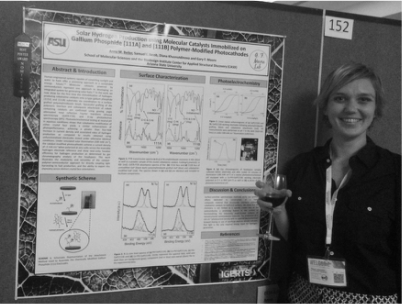Media and Press Links
|
(artwork by Jason Drees)
|
The design of efficient electrocatalysts is limited by scaling relationships governing trade-offs between thermodynamic and kinetic performance metrics. This ″iron law″ of electrocatalysis arises from synthetic design strategies, where structural alterations to a catalyst must balance nucleophilic versus electrophilic character. Efforts to circumvent this fundamental impasse have focused on bioinspired applications of extended coordination spheres and charged sites proximal to a catalytic center. Herein, we report evidence for breaking a molecular scaling relationship involving electrocatalysis of the oxygen reduction reaction (ORR) by leveraging ligand design. We achieve this using a binuclear catalyst (a diiron porphyrin), featuring a macrocyclic ligand with extended electronic conjugation. This ligand motif delocalizes electrons across the molecular scaffold, improving the catalyst’s nucleophilic and electrophilic character. As a result, our binuclear catalyst exhibits low overpotential and high catalytic turnover frequency, breaking the traditional trade-off between these two metrics.
|
|
Photo: ASU student Hannah Nockideneh (center) explains her research project at the BELLA Center.
|
A partnership between Arizona State University (ASU) and Lawrence Berkeley National Laboratory (LBNL) was established to create the ASU–Berkeley Lab STEM Pathways (ABSP) Program. The initiative is supported through the Alfred P. Sloan Foundation, with a goal of creating opportunities for American Indian students interested in pursuing graduate-level studies and careers in science, technology, engineering and mathematics (STEM). More information on the program and the application process is available here.
|
Daiki Nishiori is among ten outstanding students from the School of Molecular Sciences (SMS) recognized for their leadership and accomplishments at the annual College Leaders Ceremony for 2022. These students are celebrated for their contributions to society in research, business, and/or community service throughout their careers.
|
In an ASU News piece, Moore and team discuss a paradigm shift for chemistry and the production of fuels, transitioning from linear, single-use approaches to processes that adapt circular chemistry and materials that are recyclable and/or reusable.
Moore Receives 2023 Inter-American Photochemical Society (I-APS) Young Investigator Award
The Award recognizes accomplishments, achievements, and service to the Society and photochemical community.
The Award recognizes accomplishments, achievements, and service to the Society and photochemical community.

New Program Creates Pathways for Native American Student Success
The ASU-Berkely Lab program seeks to increase the number of Native American Students pursuing STEM graduate studies. The program was recently selected for a Creating Equitable Pathways to STEM Graduate Education grant from the Alfred P. Sloan Foundation.
Students interested in participating in the ASU-Berkeley Lab STEM Pathways program are encouraged to contact Professor Gary Moore.
The ASU-Berkely Lab program seeks to increase the number of Native American Students pursuing STEM graduate studies. The program was recently selected for a Creating Equitable Pathways to STEM Graduate Education grant from the Alfred P. Sloan Foundation.
Students interested in participating in the ASU-Berkeley Lab STEM Pathways program are encouraged to contact Professor Gary Moore.
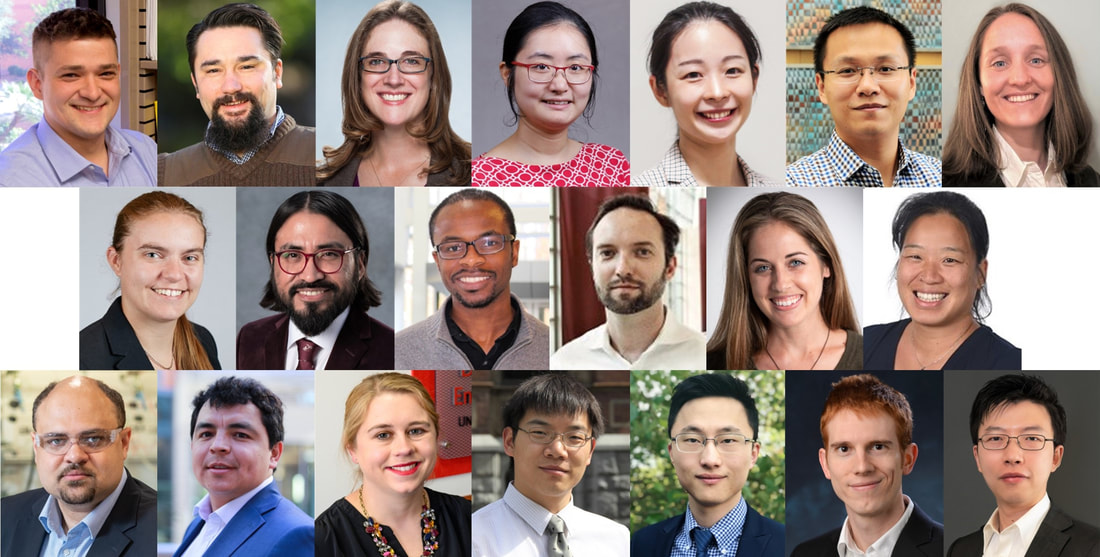
Eight cross-disciplinary teams working to advance fundamental science in the removal of greenhouse gases from Earth’s atmosphere and oceans will receive awards totaling $1,210,000 in the second year of the Scialog: Negative Emissions Science initiative, sponsored by Research Corporation for Science Advancement and the Alfred P. Sloan Foundation, with additional support from the Climate Pathfinders Foundation.

|
Nishiori, Wadsworth, and Moore Publish on Parallels Between Enzyme Catalysis, Electrocatalysis, and Photoelectrosynthesis. In this Chem Catalysis article, parallels are drawn between concepts involving enzyme catalytic efficiency, the benchmarking of molecular electrocatalysts, and the performance of photoelectrosynthetic assemblies, while highlighting key differences, assumptions, and limitations.
|
Artificial leaves that convert sunlight to fuels could provide a sustainable energy future. But several challenges must be overcome to improve their economic viability.
|
The Communication is titled Six-electron Chemistry of a Binuclear Fe (III) Fused Porphyrin. The cover picture shows the transfer of six electrons between an electrode and a binuclear iron(III) fused porphyrin featuring a conjugated pi-system that delocalizes electrons across the ligand scaffold, and is part of a special issue dedicated to professor Jean-Michel Savéant.
|
The award is given annually to a graduate student for excellence in achieving the School of Molecular Sciences' mission of discovering molecular-level solutions to real-world challenges through the pursuit of methodology or development of research ideas or inventions.
Moore has earned national recognition as an emerging leader in the field of energy materials science. He is a Department of Energy Early Career Awardee, a Camille Dreyfus Teacher-Scholar, a National Science Foundation CAREER Awardee, and was recognized as an “outstanding chemist with Native American heritage” by the National Science Foundation during the 2020 Celebration of Native American Heritage Month.
|
The Letter, titled Understanding and Controlling the Performance-Limiting Steps of Catalysts-Modified Semiconductors, describes a photoelectrochemical assembly that powers hydrogen production at rates that are among the highest reported for a molecular-catalyst-modified semiconductor, and highlights the complex interplay between transport of photons, electrons, and chemical substrates in photoelectrosynthetic reactions.
|
Nguyen, et al. J. Phys. Chem. Lett. 2021, 12, 199-203.
|
|
More than 50 promising early-career scientists have been named Fellows for a new Scialog initiative, Negative Emissions Science. Co-sponsored by Alfred P. Sloan Foundation and Research Corporation for Science Advancment (RCSA), the series will begin virtually with its first conference November 5-6, 2020. Participants in Scialog: Negative Emissions Science will convene to take up the pressing challenge of greenhouse gases accumulating in Earth’s atmosphere and oceans.
|
|
This focus issue of the ECS Journal of Solid State Science and Technology honors Prof. Karl M. Kadish who turned 75 in February of 2020. The article by Wadsworth et al., titled: Electrochemistry of Polymeric Cobaloxime-Containing Assemblies in Organic and Aqueous Solvents, shows how waveform analysis, including integration of redox waves and determination of their line widths at half height, can be used to gain information on the morphology of a surface imobilized polymer and the fraction of electrochemically-active cobalt centers embeded within the polymeric surface coating.
Wadsworth, et al. ECS J. Solid State Sci. Technol. 2020, 9, 061018. |

Karl M. Kadish Schematic representation of repulsion interactions between neutral and protonated pyridyl groups within a polymeric environment.
|
Project Title: Acquisition of a femtosecond laser system for time resolved studies using Arizona States University's Compact X-ray Light Source (CXLS)
|
The direct integration of electrocatalysts with photovoltaic materials provides a strategy to photoelectrochemically power chemical transformations and store intermittent solar energy as fuels. However, many electrocatalytic components used or proposed for use in such assemblies also absorb visible light. This prompts the questions: to what extent does a selected electrocatalytic coating screen photons from reaching the underlying photovoltaic, do excited-state species associated with coating layers contribute to photocurrent production via mechanisms involving dye-sensitization processes, and are relatively high or low loadings of catalytic sites advantageous. Herein, we providing a general yet useful strategy for adressing thes questions and better understanding the origin of photocurrents and fuel production activities in catalyst-modified semiconductor electrodes.
|
Wadsworth, et al. ACS Appl. Energy Mater. 2020, 8, 7512-7519.
|

The U.S. Department of Energy (DOE) has announced the selection of 76 scientists from across the nation – including 26 from DOE’s national laboratories and 50 from U.S. universities – to receive significant funding for research as part of the DOE Office of Science’s Early Career Research Program. The effort, now in its eleventh year, is designed to bolster the nation’s scientific workforce by providing support to exceptional researchers during crucial early career years, when many scientists do their most formative work.
The Camille and Henry Dreyfus Foundation is a leading nonprofit organization devoted to the advancement of the chemical sciences. It was established in 1946 by chemist, inventor and businessperson Camille Dreyfus in honor of his brother, Henry. The foundation seeks to support the advancement of chemistry, chemical engineering, and related sciences as a means of improving human relations and circumstances around the world.

|
The design of sophisticated new materials is undergoing brisk technological advancement. Innovations in material science promise transformative improvements in industries ranging from energy to manufacturing.
|
|
WORK BY WADSWORTH AND CO-AUTHORS GRACES COVER OF ACS APPLIED MATERIALS AND INTERFACES
Inspired by nature, where amino acid residues and soft-material coordination environments regulate the midpoint potentials of metals in proteins, the rational design of molecular interfaces provides opportunities to control the electrochemistry of metals on surfaces. Herein, Wadsworth and coauthors describe the immobilization of metallocomplexes onto transparent conductive oxide supports using molecular-based attachment strategies that enable synthetic control over the redox response of the composite electrode assemblies. |
Wadsworth, et al. ACS Appl. Mater. Interfaces. 2020, 12, 3903-3911.
|
|
Wadsworth, et al. JACS.
2019, 141, 15932-15491. |
WORK BY WADSWORTH AND CO-AUTHORS GRACES COVER OF JACS
The article describes the interplay between light absorption, charge transfer and catalytic activity at molecular-catalyst-modified semiconductor liquid junctions. The related kinetics are modeled using steady-state and pre-equillibrium aproximations, yielding rate laws similar in form to those applied in studies invovling classic enzymatic reactions and Michaelis-Menten-type analysis. This work forges a link between kinetic models decribing biological ensemblies and emerging molecular-based technologies for solar energy conversion, providing a conceptual framework for extracting kinetic benchmarking parameters currently not possible to establish. |
EXTRACTING CLEAN FUEL FROM SUNLIGHT. ASU NOW reports on research from the G. F. Moore Lab, pioneering new technologies for clean and sustainable energy.
GRADUATE STUDENT BRIAN WADSWORTH APPEARS ON ARIZONA PBS CHANNEL 8 to describe his research on producing clean fuel with solar power and chemical reactions.
|
ODELLA, WADSWORTH, MORA AND CO-AUTHORS PUBLISH IN JACS (Cover Article). The article, titled: Proton-Coupled Electron Transfer Drives Long-Range Proton Translocation In Bioinspired Systems, describes the design of bioinspired molecules that employ oxidation–reduction processes to move reversibly two, three, and four protons via a Grotthuss-type mechanism along hydrogen-bonded networks up to ∼16 Å in length. These molecules are composed of benzimidazole moieties linking a phenol to the final proton acceptor, a cyclohexylimine. Following electrochemical oxidation of the phenol, the appearance of an infrared band at 1660 cm–1 signals proton arrival at the terminal basic site. Switching the electrode potential to reducing conditions reverses the proton translocation and resets the structure to the initial species.
|
Odella, et al. JACS.
2019, 141, 14057-14061. |
|
|
DIANA KHUSNUTDINOVA NAMED SPRING 2019 OUTSTANDING GRADUATE. Diana's Dissertation for the degree Doctor of Philosophy is titled: Electrocatalytic and Photoelectrosynthetic Hydrogen Production using Metalloporphyrins and Molecular-modified Gallium Phosphide Photocathodes.
|
|
WADSWORTH, KHUSNUTDINOVA, AND MOORE PUBLISH IN JOURNAL OF MATERIALS CHEMISTRY A THEMED ISSUE ON EMERGING INVESTIGATORS.
Each contributor was recommended by experts in their fields as carrying out work with the potential to influence future directions in materials chemistry. Wadsworth, et al. J. Mater. Chem. A. 2018, 6, 21654-21665. |

Khusntdinova, et al. ACS Catalysis
2018, 9, 9888-9898. |
WORK BY KHUSNUTDINOVA, WADSWORTH, AND CO-AUTHORS GRACES COVER OF ACS CATALYSIS. The cover art illustrates the molecular structure of the reported catalyst, a binuclear copper(II) fused porphyrin, and the union of two protons to synthesize the chemical product, hydrogen. Under appropriate conditions, a single molecule of the catalyst produces more than 2,000,000 molecules of hydrogen per second (a rate constant among the highest reported in the literature). This work explores the concept of leveraging extended aromaticity as a strategy for breaking unfavorable scaling relationships associated with multi-proton multi-electron redox catalysis and providing an alternative to use of electron withdrawing or donating substituents to favor electron transfer at reduced bias potentials while unfavorably altering kinetics of associated proton transfer steps.
|
|
ASU SCHOLARS, STUDENTS, EMBEDDED IN INDIGENOUS COMMUNITIES WITH RESEARCH IN INDIGENOUS COMMUNITIES. ASU has a wide breadth of research and interactions taking place in Indian Country. Health care, language preservation, molecular sciences, sustainability, research methodologies, and higher education experiences were among the topics discussed at the 2018 Doing Research in Indigenous Communities Conference. |

|
|
Odella, et al. JACS
2018,140, 15450-15460 |
ODELLA, MORA, WADSWORTH, AND CO-AUTHORS PUBLISH IN JACS. The article, titled: Controlling Proton-Coupled Electron Transfer in Bioinspired Artificial Photosynthetic Relays, reports on Bioinspired constructs consisting of benzimidazole-phenol moieties bearing N-phenylimines as proton-accepting substituents designed to mimic the H-bond network associated with the TyrZ-His190 redox relay in photosystem II. In these constructs, the extent of proton translocation along the H-bond network, either ∼1.6 Å or ∼6.4 Å, can be controlled through imine substitution.
|
|
WORK BY KHUSNUTDINOVA AND CO-AUTHORS FEATURED ON JOURNAL OF PORPHYRINS AND PHTHALOCYANINES COVER. The article, titled: Vibrational structure analysis of cobalt fluoro-porphyrin surface coatings on gallium phosphide, demonstrates the use of GATR–FTIR spectroscopy as a sensitive tool for characterizing porphyrin-modified surfaces with absorption signals that are close to the detection limits of many common spectroscopic techniques.
Khusntdinova, et al. J. Porphyrins Phthalocyanines. 2018, 22, 461-468. |

|
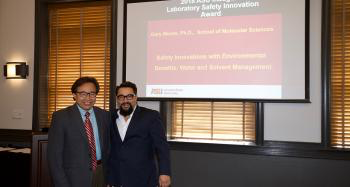
SAFE SUSTAINABLE SCIENCE EARNS ASU RESEARCHER PRAISE. Moore (right) accepts the Laboratory Safety Innovation Award from Professor Jingyue Liu, chair of the safety and outreach subcommittee of the University Laboratory Safety Committee. Moore’s work to both conserve water and increase safety earned him and his group the inaugural award.
|
Ardo, et al. Energy Environ. Sci.
2018, 11, 2768-2783. |
PATHWAYS TO ELECTROCHEMICAL SOLAR-HYDROGEN TECHNOLOGIES. This article condenses the perspectives of ~50 basic scientists, engineers, and social scientists, from academia, government, and industry, and reports on high-potential pathways for commercialization opportunities of solar-hydrogen technologies. By doing so, the article identifies key barriers for the deployment of these technologies both in the short term and long term. The insights provided in this perspective paper intend to contribute to defining new directions for research in the solar fuels field, and to enable future solar-hydrogen ventures that capitalize on technical advances from the scientific community.
|
|
BEILER AND COWORKERS PUBLISH IN INORGANIC CHEMISTRY. The article describes how thin-film polypyridyl surface coatings can be used to assemble cobalt porphyrin catalysts for hydrogen production onto a a gallium phosphide semiconductor. Key features of the hybrid photocathode include the use of visible light to drive cathodic fuel-forming reactions in aqueous solutions with no added organic acids or sacrificial chemical reductants.
Beiler, et al., Inorg. Chem.
2017,56, 12178-12185 |
MOORE RECEIVES NATIONAL SCIENCE FOUNDATION CAREER AWARD. The CAREER award is the National Science Foundation's most prestigious and competitive honor for early-career investigators. CAREER awards support junior faculty who exemplify the role of teacher-scholars through research, education and the integration of education and research within the context of the mission of their organizations.
|
KHUSNUTDINOVA AND COWORKERS PUBLISH IN PHOTOSYNTHETICA. The article is part of a special issue dedicated to Govindjee and describes the synthesis and characterization of a novel cobalt(II) 5,10,15,20-tetrakis (3-fluorophenyl)porphyrin bearing a 4-vinylphenyl surface attachment group at a beta position on the macrocycle.
Khusnutdinova, et al.,
Photosynthetica.2018,1, 67-74. |
|
ANNA M. BEILER RECEIVES CLAS GRADUATE EXCELLENCE AWARD AND ARCS FOUNDATION SCHOLORSHIP.
Beiler's thesis research is specifically focused on methods to interface molecular catalysts that can produce fuels, such as hydrogen or reduced forms of carbon dioxide, with visible-light absorbing semiconductors. |

U.S. RESEARCHERS SUPPORT "SOLAR FUELS INNOVATION ACT", prompting an initiation to expand scientific knowledge about converting solar energy into chemical energy. Specifically, supporting research about: (1) replicating natural photosynthetic processes in artificial photosynthesis processes, and (2) generating a variety of fuels produced from sunlight through artificial photosynthesis. (A photosynthetic process is one used by plants to convert light from the sun into chemical energy. Artificial, human-made photosynthesis mimics the natural process.)

DIANA KHUSNUTDINOVA AND ANNA M. BEILER RECEIVE RECOGNITION AT THE 2017 BIODESIGN FUSION RETREAT. Diana Khusnutdinova was invited to present results form her publication in Chemical Science and Anna. M Beiler received the Marie Curie Award For Best Use of Chemistry.
|
|
WADSWORTH AND COWORKERS PUBLISH IN ACS CATALYSIS, reporting how the unique encapsulating environments of surface-grafted polymeric architectures provide a molecular strategy for improving the chemical stability of surface-immobilized catalysts. Wadsworth, et al. ACS Catal.
2016, 6, 8048-8057 |

Photosynthesis: Structures, Mechanisms, and Applications
Editors: Hou, H.J.M., Najafpour, M.M., Moore, G.F.,
Allakhverdiev, S.I. (Eds.)
Covers several very new topics on photosynthesis, all under one volume
Editors: Hou, H.J.M., Najafpour, M.M., Moore, G.F.,
Allakhverdiev, S.I. (Eds.)
Covers several very new topics on photosynthesis, all under one volume

ANNA BEILER PARTICIPATES AS A DISCUSSION LEADER IN THE 2016 ELECTRON DONOR ACCEPTOR INTERACTIONS GORDON RESEARCH SYMPOSIUM SESSION: ELECTRON TRANSFER IN MOLECULES AND BEYOND.
KHUSNUTDINOVA AND COWORKERS PUBLISH IN CHEMICAL SCIENCE. The 'Edge Article' describes a novel synthetic methodology to chemically graft metalloporphyrin catalysts to a visible-light-absorbing semiconductor with the aim of constructing an integrated photocathode for light activating chemical transformations that include converting solar energy to fuels. Characterization of a cobalt-porphyrin based assembly under simulated 1-sun illumination indicate the highest per metal site turnover frequency of hydrogen production reported to date for a molecular-catalyst-modified semiconductor photoelectrode operating at the proton/hydrogen equilibrium potential.
Khusnutdinova, et al. Chem. Sci.
2017, 8, 253-259.
2017, 8, 253-259.
NEWS THE LATEST: ENERGY INNOVATION: TAPPING THE POWER OF THE SUN
Photo: (From left to right) Samuel I. Jacob, Diana Khusnutdinova, Anna M. Beiler and Gary F. Moore)
Photo Credit to Joseph Caspermeyer
Photo: (From left to right) Samuel I. Jacob, Diana Khusnutdinova, Anna M. Beiler and Gary F. Moore)
Photo Credit to Joseph Caspermeyer



















